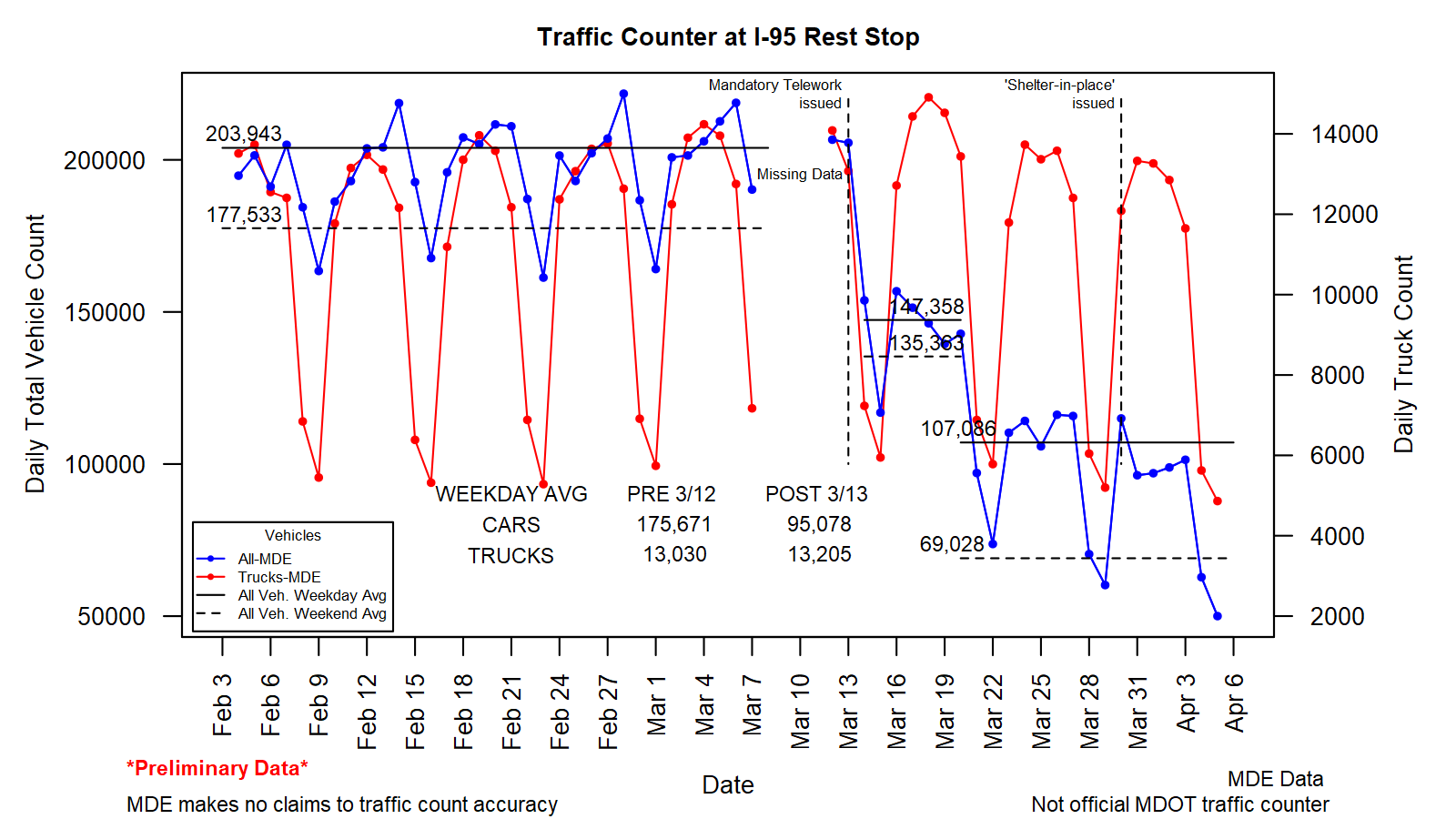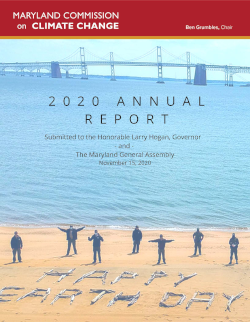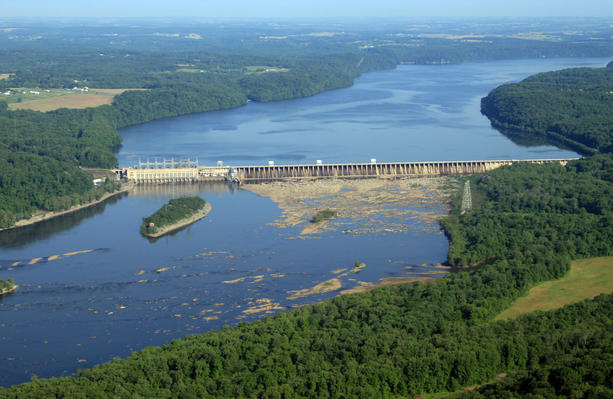eMDE – Ben’s Blog: 2020 year in review



2020 – THE YEAR IN REVIEW
COVID, Climate, and Chesapeake dominated this historic and traumatic year of 2020 for us at the Maryland Department of the Environment (MDE) in nearly all respects, literally, figuratively, and virtually (digitally speaking). The COVID-19 crisis hurt our employees, families, and communities but also helped to modernize and energize MDE’s work to deliver on its noble mission: protecting and restoring the environment for the health and well-being of all Marylanders. This infectious spirit permeated and positively affected our efforts on climate change and Chesapeake Bay restoration.
A scientific silver lining

After major actions were taken in March – including restrictions on the size of gatherings, the closing of schools, mandatory teleworking for non-essential state workers and a Stay at Home Order – MDE and the agency’s long time partners at the University of Maryland looked at the effect on air quality and emissions of greenhouse gases that contribute to climate change. Researchers found a temporary reduction in vehicle traffic and power plant emissions, along with air quality and greenhouse gas benefits. The results provided a preview of the benefits we could expect with a significant increase in the number of zero emission vehicles on our roads and tightened emissions from power plants, along with the benefits of an ongoing emphasis on teleworking when possible. This was all about science to inform environmental policy for sustainability and vibrancy, while recognizing the pain and suffering of our severely restricted economy.
Enforcement
During the global pandemic, MDE has used its enforcement discretion on a careful and limited basis. Protection of public health and the environment continues to be the priority with each decision. The department, unlike the U.S. Environmental Protection Agency, did not issue a broad, upfront policy on pandemic-related leniency, and that has helped significantly in reducing the number of Maryland entities seeking delays or waivers.
Most requests for enforcement discretion during the pandemic asked for flexibility on the timing of monitoring reports due to closure of facilities and reduction of staffing. Most of the remainder of the requests were seeking approval for digital reporting and changes in operating hours. MDE has also participated in a national task force of states and EPA enforcement experts to develop protocols and best practices for video-enhanced inspections to supplement more traditional onsite and unannounced inspections. Click here to view the requests and actions taken.
Sewer Sentinel Initiative

In December, after months of pilot testing in communities and partnership building around the nation, MDE launched a widely acclaimed initiative to sample wastewater as an early warning system of a COVID-19 outbreak in vulnerable Maryland communities. As part of Maryland’s Sewer Sentinel Initiative, Governor Hogan approved funding of $1 million to sample wastewater for the virus that causes COVID-19 in congregate living settings. MDE, in close coordination with the Maryland Department of Health, is leading the testing effort.
This next phase of the Sewer Sentinel Initiative builds upon information obtained during a pilot project that began this summer in five communities across the state. The pilot project confirmed that wastewater sampling could provide advance notice of an outbreak before patient symptoms and clinical testing might reveal a problem. Under the Sewer Sentinel Initiative, dozens of sites in congregant living settings will supplement more traditional testing and tracing efforts to save lives and stop the spread of the virus. MDE was one of the early proponents of this approach and because of the Governor’s leadership, we are setting a shining example for the nation on cutting-edge scientific partnerships for public health.
Environmental progress continues
Our work for cleaner air, water, land and materials continued in 2020, highlighted by local actions and regional collaborations that serve as national examples of bipartisan, balanced solutions.
On the climate change and clean air fronts, we continue to make meaningful progress. The Regional Greenhouse Gas Initiative (RGGI), which Maryland helps to lead, delivers real results in slashing carbon pollution from power plants and providing investments in clean and renewable energy. December saw the 51st auction of emissions allowances, with a $7.41 clearing price that means steady, continued progress for the nation’s oldest cap and invest program to combat climate change and $17.4 million in proceeds for Maryland, up from the last RGGI auction.
In November, MDE finalized regulations to phase out the use of hydrofluorocarbons and reduce methane emissions to help meet the state’s aggressive climate goals. Also that month, the independent, bipartisan Maryland Commission on Climate Change, which MDE chairs and supports, issued its annual report, listing as priorities building broader partnerships with federal, state, and local governments and the private sector to reduce greenhouse gas emissions, and preparing for further impacts of climate change in Maryland. The action-oriented recommendations underscored the urgency of the situation as well as the need for greater diversity, equity, inclusion, and climate justice.


Last summer, the Hogan administration joined a multi-state clean trucks and transportation initiative, committing to work with other states to reduce emissions from trucks, buses, and other large vehicles to improve air quality and combat the effects of climate change. Under a Memorandum of Understanding signed by Governor Larry Hogan, the governors of 14 other states, and the mayor of Washington, D.C., the signatories will collaborate to dramatically increase the number of electric medium- and heavy-duty vehicles — pursuing an aspirational goal of all sales of these vehicles being zero-emission models by 2050. Maryland continues to take actions within the state and collaborate with others throughout the broader region for clean air and climate progress in the transportation sector.
A report by the widely respected World Resources Institute put the spotlight on Maryland as a national leader on climate change. Out of all 50 states, Maryland is No. 1 in carbon dioxide emissions reductions, all while the state has increased real gross domestic product to benefit its economy. The nation would do well to follow Maryland’s example, which is the result of a commitment to sound science that guides decisions to reduce greenhouse gas emissions and build resilience to climate change while also committing to the growth of Maryland jobs and the state’s economy.
Maryland also continues to lead on Chesapeake Bay restoration. Governor Hogan, chairman of the Chesapeake Executive Council from 2017-2020, wrote to congressional leaders calling for a reversal of proposed cuts to federal funding for Chesapeake Bay restoration and noting that the Hogan administration has committed a record investment of more than $6 billion in bay restoration. In a November letter to the Biden-Harris transition team, Governor Hogan again advocated to maintain historic funding for the Chesapeake Bay to help sustain recent progress and meet restoration goals by the 2025 deadline, and also commit to prioritize investments for infrastructure resiliency.
In September, Maryland joined in a multi-state lawsuit against the EPA over the federal agency’s failure to require Pennsylvania and New York to develop and implement plans to achieve bay restoration goals. Governor Hogan had pressed for a lawsuit from day one if EPA and states in the Susquehanna River watershed failed to honor their Chesapeake commitments under the Clean Water Act. Our lawsuit has been a necessary step to get EPA and our partners upstream and upwind to do their fair share to protect our beloved Bay.
We also made progress on the longstanding problems surrounding the almost 90-year-old Conowingo dam on the Susquehanna River, which delivers half of the fresh water flows to our Bay. In October, the multi-state Chesapeake Bay Program issued a draft Conowingo Watershed Implementation Plan (WIP) for public comment. (WIP). The Conowingo WIP identifies actions to be taken by each of the watershed jurisdictions to reduce the additional pollution resulting from the inability of the reservoir behind the dam to trap nutrients from flowing downstream into the bay. Then in November, Maryland announced it was able to begin the first phase of the Conowingo Dredging and Innovative and Beneficial Reuse Pilot Project. The pilot dredging project, the Conowingo WIP and the suit against EPA are part of our holistic strategy to reduce upstream pollution that threatens Bay watershed restoration goals.
The issue of PFAS (per- and polyfluoralkyl substances) compounds that are man made contaminants is a priority for Maryland. MDE led a successful pilot study that sampled surface water and oysters in the St. Mary’s River for PFAS. The pilot study is integral to MDE’s development of a comprehensive plan for PFAS, which includes sampling that has begun of water from more than 130 public drinking water treatment systems across Maryland. We also intend to analyze fish tissue samples for PFAS in several locations across the state as part of our established fish tissue monitoring program. MDE is committed to responsible and protective action related to PFAS, including the development a comprehensive plan for understanding, communicating and reducing unacceptable risk.
Earlier this year, as a first in the nation, a Maryland law took effect requiring schools and food service businesses to discontinue the sale or provision of food or beverages in expanded polystyrene (EPS) food service products. In June, MDE issued notice of a limited, three-month delay to allow the continued use of existing inventories of EPS food service products due to the COVID-19 emergency, but the law took full effect in October. MDE is committed to sustainable materials management for environmental progress and working with local governments, businesses, and educational and nongovernmental organizations to ensure success.
In the area of public health, MDE announced that childhood lead poisoning cases in Maryland decreased in 2019 to the lowest levels since data has been collected in connection with the state’s 1994 lead law. Exposure to lead is the most significant and widespread environmental hazard for children in Maryland. We have modified our procedures for conducting environmental investigations to safely continue this important work during the COVID-19 emergency.
Environmental justice took on renewed importance in 2020. We are proud of the Hogan administration’s leadership in forging the Chesapeake Bay Program’s strong statement and action plan in support of Diversity, Equity, Inclusion, and Justice. MDE began developing strategies for “restoration from the inside out,” including internal policies for workforce diversity and permitting, funding, enforcement, and public engagement involving overburdened and underserved communities, along with important revisions to the staffing and operation of the Maryland Commission on Environmental Justice and Sustainable Communities. We will continue to put a priority on environmental and energy justice through the Maryland Commission on Climate Change and on the historic clean trucks commitment signed last summer.
The Year Ahead
Our department, like every agency in the Hogan Administration, will remain focused in 2021 on COVID response and recovery. That includes monitoring environmental health, assuring regulatory compliance and transparency, and providing needed infrastructure and technical assistance to economically distressed and disadvantaged communities. MDE will also continue to advance an economy-wide greenhouse gas reduction plan that acknowledges the urgency of climate change and the importance of common sense solutions and wide-ranging partnerships for bold progress toward a cleaner and more resilient future. For Chesapeake Bay progress, we will finalize critical new regulatory permits and programs to reduce stormwater pollution, increase the use of green, nature-based infrastructure to improve climate resiliency, and promote innovate partnerships for blue and green infrastructure. We look forward to working with the incoming Biden-Harris Administration, the Maryland General Assembly, county and other local governments, stakeholders, and citizens throughout the state, with 2020 literally, figuratively, mercifully in the rear view mirror. Here’s to a clean and healthy fresh start, building upon last year’s bright spots.
• Air, Land, Water – Did You Know?

Treecycling
Do your part for Maryland’s environment by recycling your Christmas tree this year. Recycled Christmas trees can be used for mulch, soil erosion barriers and many other environmentally friendly uses. Learn more about how to recycle Christmas trees in your county on MDE’s website.
• Have an idea?

Email the editor
We’re always looking for ideas to make eMDE even better. Here’s a chance to tell us what you think. Have some thoughts on what we can do better or things you’d like to see more of? An idea for a specific story? We want to hear from you. Contact us!
MDE’s MISSION
To protect and restore the environment for the health and well-being of all Marylanders.
Maryland Department of the Environment, 1800 Washington Boulevard, Baltimore, MD 21230
Maryland Department of the Environment
Copyright © 2020. All Rights Reserved.
